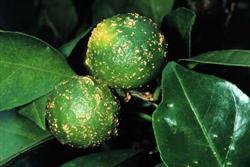Symptoms and Preventive measures of Fertilizer injury in Citrus Orchard

Symptoms of fertilizer injury of citrus appeared within 10-60 days after fertilization, first, the old leaf tip of the branch base began to lose water and turn white or yellowed and scorched, then fell, and the new leaves at the top of the branch fell or scorched on the branch. By examining the withered branches with serious fertilizer damage, it can be found that the main branches and lateral branches of the aboveground parts opposite to the fertilization site have serious skin rot. Curettage observation showed that the bark was green and brown, and the branches withered and lost water. According to the observation of root digging, the "hemp root" in the fertilization site and nearby topsoil was rotten, the root bark of fine root and thick horizontal root rotted and peeled, and extended to the root neck, trunk and main branch. Orange trees with mild fertilizer damage and survival generally cannot shoot the nearest shoots. If the fertilizer damage occurs before flowering, they cannot bud and blossom. The cause of fertilizer damage is related to the type of fertilizer, the method of fertilization and the degree of soil dryness and wetness of orange orchard. Fertilizer damage to orange trees is rarely caused by the application of soil mixed organic fertilizer or mixed application of chemical fertilizer and soil fertilizer, but it is easy to occur when chemical fertilizer is applied alone. In the same chemical fertilizer, citrus with ammonium chloride was most prone to fertilizer damage, followed by ammonium sulfate, urea, ammonia, ammonium bicarbonate and so on, while fertilizer damage was less when applying compound fertilizer and superphosphate. Heavy dosage and improper fertilization methods are the main causes of citrus fertilizer damage. With the same amount of fertilizer application, the dry application of digging holes is more prone to fertilizer damage than that of ditching with water. Especially when the soil is dry, when the soil is dry, it will not rain for a long time, and once it rains, the fertilizer damage may come more quickly and more seriously. The measures to prevent fertilizer damage first advocate scientific fertilization. Citrus fertilizer should be based on soil mixed organic fertilizer, which can not only provide a variety of nutrients of orange trees, but also improve soil structure, and the fertilizer effect is longer. Winter and spring base fertilizer is more suitable for cake fertilizer, fence fertilizer, garbage, river pond mud and human dung and so on. The effect of soil miscellaneous fertilizer is better after it is rotten, if it is not stacked and mature, it is better to dig trenches outside the crown drip line when it is used. When using chemical fertilizer as topdressing, it must be poured with water, and do not dig holes for dry application when the soil is dry. The amount of fertilizer should not be too much, especially nitrogen fertilizer should be paid more attention to. For orange trees with an annual output of 50 kg, the amount of pure nitrogen applied each time should not exceed 250 grams. Dressing fertilizer outside the root, the concentration of fertilizer solution should not exceed 0.5%. After emergency treatment of fertilizer damage, when the old leaves at the base of the branch are scorched and peeled off, the soil at the fertilization site should be removed quickly, and the soil in the fertilizer cave should be washed with clean water to dilute the concentration of soil fertilizer solution, cut off the rotten and dead roots, and then cover the new soil. Scrape off the rotten skin of the root neck and trunk, apply fungicides to prevent the spread of rotten spots, and cut off the dead branches.
- Prev

Six methods of Irrigation in Citrus Orchard
The main results are as follows: (1) Amoy irrigation is also called immersion irrigation. That is, the trench is opened between the rows of the citrus orchard and connected with the water transport channel, and the irrigation water seeps into the soil through the bottom and wall of the ditch. This method is often used at present. (2) flood irrigation builds ridges in the orange orchard and diverts water from the orchard. This method consumes a lot of water, the topsoil is easy to harden, and the soil is not permeable.
- Next

Control of diseases and insect pests in citrus in summer and autumn
1. Whitefly: both adults and larvae can harm the leaves and fruits of citrus, absorb juice by piercing mouthparts, secrete a large amount of honeydew to pollute leaves and fruits, and cause bituminous disease. White whitefly has rapid reproduction, many hosts and easy to spread, so it is necessary to adopt large-scale joint control in order to achieve good results. ⑴ prevention time: when.
Related
- Moge, come on! The staff of the peasant association in the producing area of cantaloupe were frightened when the crowd gathered.
- Causes and Solutions of low Fruit setting rate of Apple
- Symptoms and control measures of passion fruit virus disease
- Fruit growing lesson: how do apple orchards keep high yields?
- Can you build orchards in the mountains? What are the pros and cons?
- How to manage the coloring period of Crisson grape?
- This paper introduces the processing technology of two kinds of fig products.
- How much is a month for retired teachers in rural areas by 2020?
- How can strawberry planting increase sugar content? We should pay attention to management in many aspects.
- What are the cultivation techniques on how to improve the yield of golden fruit?

